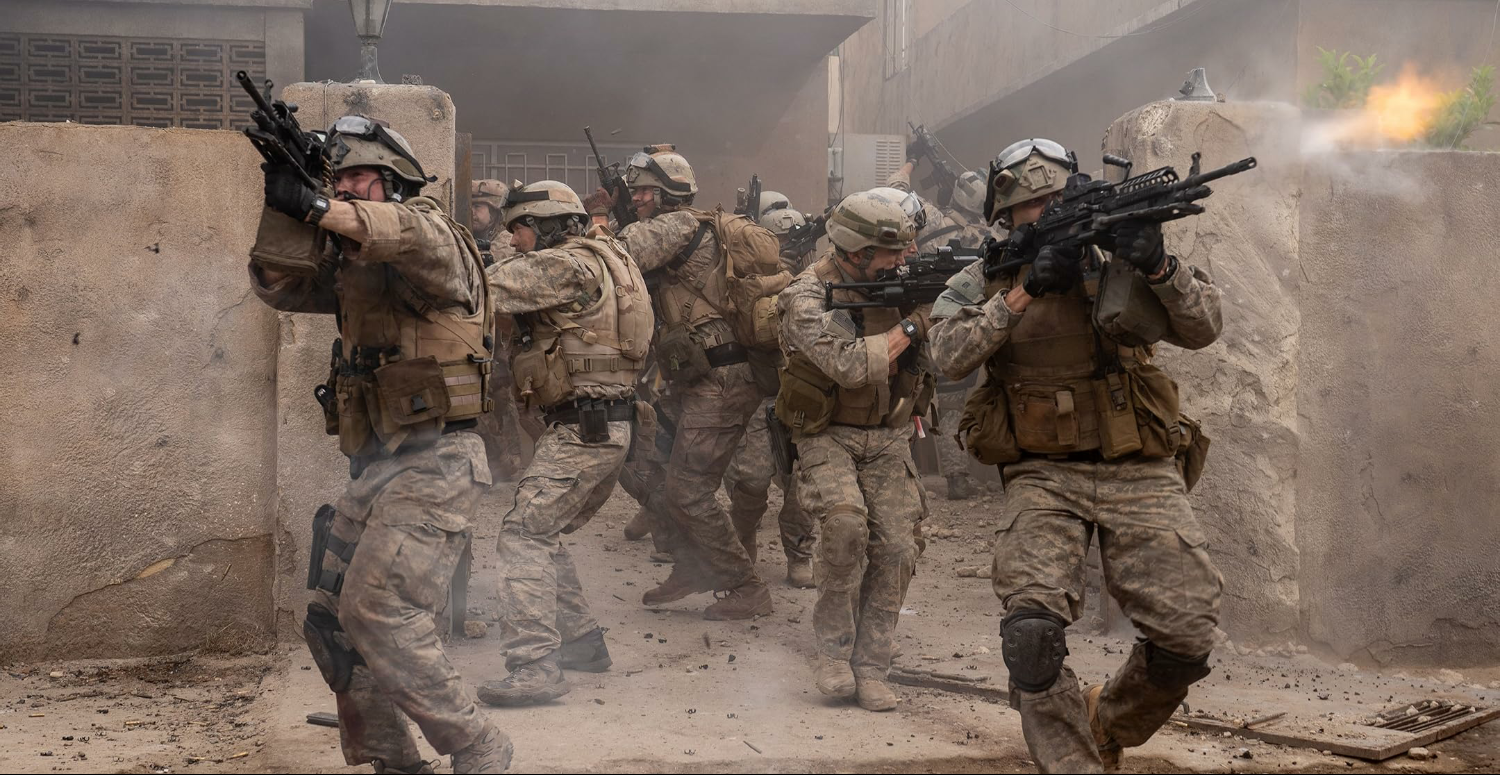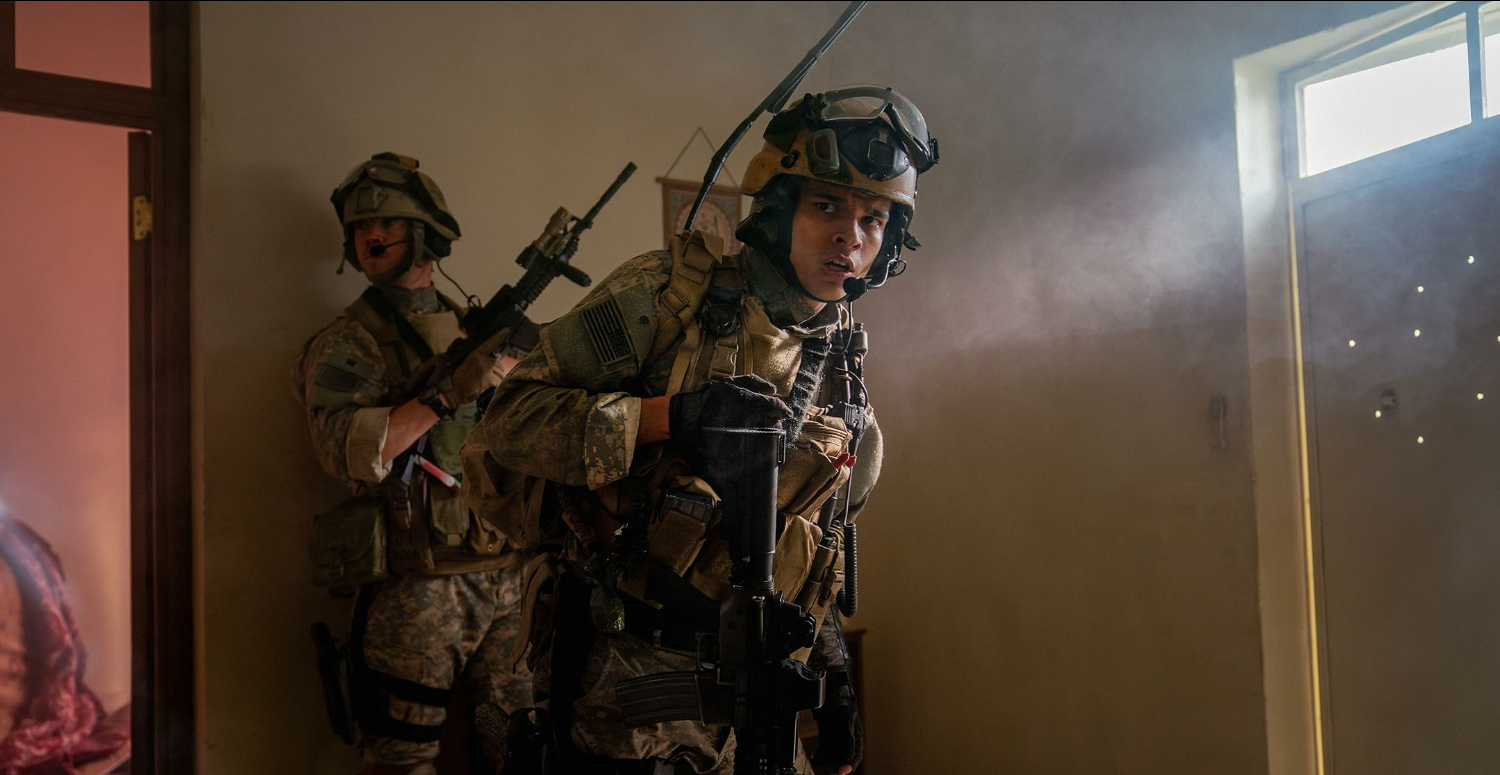Warfare
2025

FR EN
Un an après la claque qu’était « Civil War », le réalisateur britannique Alex Garland (Ex Machina ; Annihilation) revient avec un autre projet radical co-écrit et réalisé avec le vétéran américain Ray Mendoza. A nouveau produit par les studios A24, le film offre une vision brute du conflit irakien en 2006 en nous plongeant dans l’histoire vraie d’une périlleuse mission de surveillance à Ramaldi qui va vite tourner au chaos. L’intégralité du film se concentre ainsi sur cette seule et unique opération sur moins d’une journée avec une narration en temps réel (après l’introduction) où le spectateur est embarqué au sein du peloton de Navy SEALs dont faisait partie le co-réalisateur. C’est en cela plus un film de mémoire(s) qu’un film de guerre, car le parti pris de ce projet consiste à n’utiliser que les souvenirs des différents soldats. « Warfare » est ainsi un titre approprié tant il s’agit véritablement d’une plongée dans l’opération militaire, sans aucune considération géopolitique ou sociale, aucun développement de personnage, zéro contexte, pas même le moindre briefing de mission : que de l’attente, de la tactique, des protocoles, du combat et du travail d’équipe. Le film privilégie donc avant tout le réalisme au scénario, et la vérité aux fusillades hollywoodiennes dans une intense reconstitution des combats et une saisissante représentation de la fraternité guerrière.
Ce manque de contexte peut paraître gênant mais c’est aussi tout le propos du film en reflétant le sort des soldats envoyés sur le champ de bataille sans trop savoir pourquoi ni quoi faire. Car « Warfare » est un huis-clos étendu aux alentours d’une maison que les soldats occupent (à l’image du pays) durant tout le film. Il se résume à infiltrer la maison puis réussir à en sortir vivant. Le film s’ouvre et se clôt donc littéralement sur elle, ce lieu unique et finalement presque personnage central du récit. La fin en est d’autant plus frappante en restant – une fois les soldats partis – dans ce lieu, dans ces décors dévastés, ces rues vides de soldats blessés et épuisés où seule la confusion et un sinistre silence demeurent … tout cela sans savoir qui a remporté cette bataille ou même pour quoi ils se sont battus (renvoyant bien évidemment à la guerre en Irak dans sa globalité).

A travers ces deux co-réalisateurs et co-scénaristes, « Warfare » pousse à l’extrême à la fois une dimension immersive et une dimension viscérale du film de guerre.
Pour l’un (Ray Mendoza, dont c’est aussi le premier long-métrage) c’est évidemment un film de mémoire et un film hommage à ses frères d’armes sans qui il ne serait peut-être plus en vie. Les détails techniques et opérationnels font alors foison, des comportements, mouvements, et communications radio des soldats jusque dans une décision absolument majeure dans le domaine militaire qui aura probablement d’importantes conséquences pour l’officier responsable. Pourtant à la fin du film, on n’y pense même plus tant il a continué sa route sans mettre en valeur cette prise de décision. En somme c’est un film de guerre, oui, mais qui esquive les codes hollywoodiens, sans aucune musique, sans discours de bravoure, sans dramatisation : que du sang et de la poussière. C’est une reconstitution très littérale, apolitique et objective de faits réels qui s’impose comme l’un des films de guerre qui romance le moins son sujet. Il n’y a aucun message, c’est un récit brut raconté à partir de souvenirs qui renforcent cette volonté de réalisme et d’immersion.
Pour l’autre (Alex Garland) c’est une nouvelle expérience viscérale de cinéma dans la continuité du style visuel et sonore de « Civil War » avec notamment le retour des monteurs son Glenn Freemantle et Ben Barker qui nous bombardent de silences puis d’explosions et de balles qui fusent. Le film joue des points de vue en parcourant les souvenirs des soldats, nous rendant aussi sourds qu’eux lorsque survient un impact d’explosif pour ne retrouver le son que lorsque l’on retrouve ceux hors de portée du souffle. Le point de vue de l’officier radio nous permet par ailleurs à la fois d’avoir les éléments de contexte des autres unités alentour, mais aussi de créer un véritable brouhaha chaotique tel qu’il a pu l’expérimenter dans cette situation. De manière générale, la maîtrise exceptionnelle du son, de l’image et du montage met en scène les combats et les explosions différemment pour rendre la violence et l’angoisse d’autant plus palpables. Il n’y a ainsi aucun plan sur les ennemis (anonymes) visés et tués, c’est laissé intégralement en hors-champ puisque l’objet n’est tout simplement pas la bravoure ou l’expertise de ces soldats d’élite, mais plutôt leur souffrance. Bien qu’il ne consacre aucune minute à les développer, le film se concentre alors sur les réactions de ses personnages joués par une troupe de qualité bien loin des clichés habituels pour nous transmettre cette confusion, cette peur, et toute cette terreur du combat !

Voilà donc un projet atypique qui s’inscrit dans le cadre classique du cinéma de guerre, et s’impose comme une véritable expérience de cinéma à voir définitivement en salles (quel dommage qu’il sorte directement sur Prime en France – sans le moindre bruit d’ailleurs). « Warfare » est un film sous tension pendant ses 90 minutes (qui ne paraissent pas si courtes que cela au vu de l’effroi des scènes), c’est un film difficile à voir (pour toute âme sensible ou vétéran souffrant de PTSD), particulièrement bouleversant et implacable.
Raphaël Sallenave
A year after the spectacular “Civil War”, British director Alex Garland (Ex Machina; Annihilation) is back with yet another radical project, co-written and directed with American war veteran Ray Mendoza. Once again produced by A24 Studios, the film offers a raw insight into the Iraqi conflict in 2006, immersing us in the true story of a harrowing surveillance mission in Ramaldi that quickly spirals into chaos. The entire film in fact focuses on this single operation over less than a day, with a real-time narrative (after the opening) in which the viewer is essentially embedded in the Navy SEALs platoon to which the co-director belonged. In that respect, this is more a remembrance film than a war film, since the approach here is to use only the memories of the various soldiers. “Warfare” is then a fitting title, as it’s really a deep dive into the military operation, with no geopolitical or social considerations, no character development, zero context, not even the slightest mission briefing: just the wait, the tactics, the protocols, the combat and the teamwork. The film therefore favors realism over script, and truth over Hollywood gunplay, in an intense recreation of combat and a striking depiction of military brotherhood.
This lack of context may seem bothersome, but it’s also the whole point of the film, reflecting the fate of soldiers sent to the battlefield without really knowing why or what to do. After all, “Warfare” is a kind of closed-door film, set within the surroundings of a house that the soldiers occupy (just like the country itself) throughout the entire movie. It boils down to infiltrating that house and getting out alive. So, the film quite literally opens and closes on the house itself, this single location and almost central character of the story. The ending is then all the more striking as we remain – once the soldiers have left – in this place, in these devastated sets, these empty streets of wounded and exhausted soldiers where only confusion and an eerie silence remain… all this without knowing who won this battle or even what they were fighting for (obviously echoing the war in Iraq as a whole).

With its two co-directors and co-writers, “Warfare” takes both the immersive and visceral dimensions of the war film to new heights.
For one of them (Ray Mendoza, whose directorial debut this is), it’s obviously a film of recollection and a tribute to his brothers-in-arms, without whom he might no longer be alive. Technical and operational details then abound, from the soldiers’ behavior, movements and radio communications to an absolutely paramount military decision that will probably have far-reaching consequences for the commanding officer. And yet, by the end of the film, we don’t even think about it any more, since the movie has moved on without emphasizing the importance of this decision. Ultimately, this is a war film, yes, but one devoid of Hollywood grammar, with no score, no heroic speeches, no dramatization: just dust and blood. It’s a very literal, apolitical and objective recreation of real events, and stands out as one of the war films that least romanticizes its subject. There’s no message, just a raw account told from memories that further strengthen the film’s commitment to realism and immersion.
For the other (Alex Garland), it’s another visceral cinematic experience in line with the visual and sound approach of “Civil War”, with sound designers Glenn Freemantle and Ben Barker returning to blast us with silences, explosions and flying bullets. The film explores the soldiers’ memories from different points of view, leaving us as deaf as they are when an explosive impact hits, only to regain sound when we recover those beyond the blast’s range. Meanwhile, the radio officer’s point of view not only gives us contextual information about the other troops in the vicinity, but also creates the chaotic hubbub he himself experienced in this situation. Generally speaking, the exceptional craftsmanship of sound, image and editing brings the fighting and explosions to life in new ways, making the violence and anguish all the more tangible. For example, there are no shots of the (faceless) enemies being shot and killed; those are left entirely out of frame, since the point is simply not the bravery or expertise of these elite soldiers, but rather their suffering. Although it doesn’t spend a single minute developing them, the film then focuses on the reactions of its characters, played by a talented ensemble cast far from the usual stereotypes, to let us feel the confusion, the fear and the sheer terror of combat!

In other words, this is an atypical project within the classic framework of war films, and it stands out as a true cinematic experience that should definitely be seen in theaters (what a pity that it’s being released directly on Prime in France – and without the slightest fuss, by the way). “Warfare” is a nerve-wracking tension for 90 minutes (which don’t seem all that short given the sheer horror of the scenes), and a hard-watch (for any sensitive soul or veteran suffering from PTSD), a particularly shattering and relentless film.
Raphaël Sallenave

